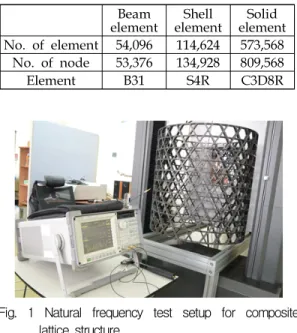한국추진공학회 2017년도 춘계학술대회 논문집 pp.832~834 2017 KSPE Spring Conference 832 -1. 서 론 복합재 격자구조체는 복합재와 최적의 형상 설계를 통해 경량화를 극대화한 구조물이다. 러 시아, 미국 등의 선진국에서는 항공기 동체, 우 주발사체 등에 복합재 격자구조체를 적용하고 있다[1]. 복합재 격자구조체는 설계 단계에서 구 조물의 구조안전성 평가가 수행되어야 하는데 * 한밭대학교 기계공학과 ** 한국화이바 특수사업본부 †교신저자, E-mail: shin955@hanbat.ac.kr
고유진동수 시험을 통한 복합재 격자구조체의
유한요소모델 검증
임재문* ․ 신광복*† ․ 이상우**Verification of Finite Element Model for Composite Lattice
Structures through Natural Frequency Test
Jaemoon Im* ․ Kwangbok Shin*† ․ Sangwoo Lee**
ABSTRACT
In this paper, the finite element models for composite lattice structures were verified through natural frequency test. Finite element models of composite lattice structure were generated using beam, shell and solid element. Natural frequencies were measured using impact test method under free-boundary condition. The natural frequencies of finite element analysis for shell and solid element showed a good agreement with experimental results. But beam element did not show a good agreement with experimental results, because beam element could not consider the degradation of mechanical properties of non-intersection parts for composite lattice structure.
초 록 본 논문에서는 고유진동수 시험을 통해 복합재 격자구조체의 유한요소모델을 검증하였다. 복합재 격 자구조체의 유한요소모델은 빔, 쉘 그리고 솔리드 요소를 사용하여 생성하였다. 고유진동수는 자유 경 계조건 하에서 충격시험법을 사용하여 측정하였다. 쉘과 솔리드 요소의 유한요소해석 결과, 고유진동수 시험과 잘 일치하는 것을 확인하였다. 빔 요소는 섬유 비교차부의 물성저하를 고려하지 못하여 오차가 발생된 것으로 판단된다.
Key Words: Composite Lattice Structure(복합재 격자구조체), Natural Frequency(고유진동수), Finite Element Analysis(유한요소해석)
833 -시험적 평가를 수행하는 것을 매우 많은 시간과 비용이 소요된다. 따라서 검증된 유한요소해석적 방법을 통해 구조안전성을 평가하는 것이 매우 경제적이다. 본 연구에서는 복합재 격자구조체의 고유진동수를 측정하고 이를 유한요소해석 결과 와 비교하여 유한요소모델을 검증하였다. 2. 복합재 격자구조체의 유한요소모델 연구에 적용된 복합재 격자구조체는 직경 600mm, 높이 617.87mm의 원통형 구조이며 Toray사의 T700 탄소섬유를 필라멘트 와인딩하 여 제작하였다. 헬리컬 리브와 후프 리브가 각각 24개와 10개로 구성되어 있다. 리브는 6.7mm의 폭과 16.5mm의 두께를 가지며 헬리컬 리브는 32°의 각도로 제작되었다. 복합재 격자구조체의 유한요소모델 검증을 위해 Table 1과 같이 ABAQUS 6.13을 이용하여 빔(beam), 쉘(shell) 그리고 솔리드(solid) 요소를 사용하여 모델을 생 성하였다.
Beam
element elementShell elementSolid No. of element 54,096 114,624 573,568 No. of node 53,376 134,928 809,568 Element B31 S4R C3D8R Table 1. Finite elements used to composite lattice
structure
Fig. 1 Natural frequency test setup for composite lattice structure 3. 복합재 격자구조체의 고유진동수 측정 복합재 격자구조체의 고유진동수는 임팩트 해 머, 가속도 센서, 오실로스코프를 사용하여 측정 하였다. 이때 와이어를 이용해 구조물을 매달아 자유 경계조건 하에서 시험을 수행하였으며 10 회 측정 후 평균값을 고속 푸리에 변환을 통해 고유진동수를 도출하였다. Fig. 1은 고유진동수 측정 모습을 보여준다. 고유진동수는 4차 모드까지 측정하여 유한요 소해석 결과와 비교하였다. Table 2에서 보듯이 쉘과 솔리드 모델의 경우, 시험과 잘 일치하는 결과가 도출되었다. 그러나 빔 모델에서는 오차 가 크게 발생하였으며 이는 섬유 비교차부의 물 성 저하를 고려하지 못하기 때문으로 판단된다.
Test elementBeam elementShell elementSolid 1st Mode 4.00Hz 4.51Hz 4.28Hz 3.68Hz
2nd Mode 12.00Hz 12.52Hz 11.84Hz 10.26Hz
3rd Mode 20.00Hz 23.48Hz 22.05Hz 19.33Hz
4th Mode 30.00Hz 36.88Hz 34.38Hz 30.60Hz
Table 2. The comparison of natural frequencies between experiment and numerical analysis
4. 결 론 본 논문에서는 복합재 격자구조체의 고유진동수 시험 을 통해 유한요소모델의 검증을 수행하였다. 빔, 쉘 그리 고 솔리드 모델을 이용한 유한요소해석 결과, 쉘과 솔리 드 모델이 시험 결과와 잘 일치하는 것을 확인하였다. 후 기 본 논문은 민군협력진흥원의 민·군기술협력사 업의 지원으로 수행되었으며, 이에 감사드립니 다.
834
-참 고 문 헌
1. Vasiliev, V. V., Barynin V. A., Rasin A. F., “Anisogrid Lattice Structures – Survey of Development and Application,” Composite Structures, 54, 361-370, 2001.
